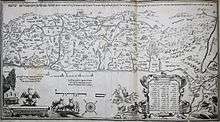Tribe of Issachar
| Tribes of Israel |
|---|
 |
| The Tribes |
| Related topics |
According to the Hebrew Bible, the Tribe of Issachar (Hebrew: יִשָּׂשכָר, Modern Yissakhar, Tiberian Yiśśâḵār) was one of the twelve tribes of Israel. It is one of the ten lost tribes. In Jewish tradition, the tribe of Issachar was seen as being dominated by religious scholars and influential in proselytism.[1]
In the Biblical narrative of the Book of Joshua, following the completion of the conquest of Canaan by the Israelite tribes, Joshua allocated the land among the twelve tribes. The territory which it was allocated was immediately north of (the western half of) Manasseh, and south of Zebulun and Naphtali, stretching from the Jordan River in the east, to the coast in the west; this region included the fertile Esdraelon plain .[1] There is a consensus among scholars that the accounts in the Book of Judges are not historically reliable.[2][3][4] Alternatively, scholars and historians such as Barry G. Webb believe Judges to be a challenging book to parse and grasp, but nevertheless believe it possesses substantially greater historicity than most modern secular scholars give it credit for.[5]
References
- 1 2 Hirsch, Emil G.; Price, Ira Maurice; Schechter, Solomon; Seligsohn, M. (1906). "Issachar, Tribe of". Jewish Encyclopedia.
- ↑ K. Lawson Younger, Jr. (1 October 2004). "Early Israel in Recent Biblical Scholarship". In David W. Baker; Bill T. Arnold. The Face of Old Testament Studies: A Survey of Contemporary Approaches. Baker Academic. p. 200. ISBN 978-0-8010-2871-7.
- ↑ Carl S. Ehrlich (1999). "Joshua, Judaism and Genocide". Jewish Studies at the Turn of the Twentieth Century, Volume 1: Biblical, Rabbinical, and Medieval Studies. BRILL. p. 117. ISBN 90-04-11554-4.
- ↑ Adele Berlin; Marc Zvi Brettler (17 October 2014). The Jewish Study Bible: Second Edition. Oxford University Press. p. 951. ISBN 978-0-19-939387-9.
- ↑ Webb, Barry (December 20, 2012). The Book of Judges (The New International Commentary on the Old Testament). Grand Rapids, Michigan: Wm. B. Eerdmans Publishing Co. ISBN 978-0-8028-2628-2.